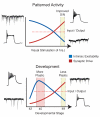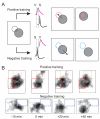Learning to see: patterned visual activity and the development of visual function
- PMID: 20153060
- PMCID: PMC3415282
- DOI: 10.1016/j.tins.2010.01.003
Learning to see: patterned visual activity and the development of visual function
Abstract
To successfully interact with their environments, developing organisms need to correctly process sensory information and generate motor outputs appropriate to their size and structure. Patterned sensory experience has long been known to induce various forms of developmental plasticity that ultimately shape mature neural circuits. These same types of plasticity also allow developing organisms to respond appropriately to the external world by dynamically adapting neural circuit function to ongoing changes in brain circuitry and sensory input. Recent work on the visual systems of frogs and fish has provided an unprecedented view into how visual experience dynamically affects circuit function at many levels, ranging from gene expression to network function, ultimately leading to system-wide functional adaptations.
Copyright 2010 Elsevier Ltd. All rights reserved.
Figures




References
-
- Ruthazer ES. You’re perfect, now change--redefining the role of developmental plasticity. Neuron. 2005;45:825–828. - PubMed
-
- Katz LC, Shatz CJ. Synaptic activity and the construction of cortical circuits. Science. 1996;274:1133–1138. - PubMed
-
- Wiesel TN, Hubel DH. Single-Cell Responses in Striate Cortex of Kittens Deprived of Vision in One Eye. J Neurophysiol. 1963;26:1003–1017. - PubMed
-
- Hooks BM, Chen C. Distinct roles for spontaneous and visual activity in remodeling of the retinogeniculate synapse. Neuron. 2006;52:281–291. - PubMed
Publication types
MeSH terms
Grants and funding
LinkOut - more resources
Full Text Sources

